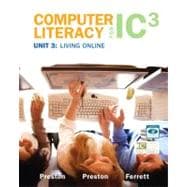
Robert L. Ferrett recently retired as Director of the Center for Instructional Computing at Eastern Michigan University, where he provided computer training and support to faculty. He has authored or co-authored more than 80 books on Access, PowerPoint, Excel, Publisher, Windows Vista, WordPerfect, and Word. He has been designing, developing, and delivering computer workshops for nearly two decades. Bob has written for the GO! Series, and was a series editor for the Learn 97, Learn 2000, and Learn XP books. He has a BA in Psychology, an MS in Geography, and an MS in Interdisciplinary Technology from Eastern Michigan University. His doctoral studies are in Instructional Technology at Wayne State University. As a sidelight, Bob teaches a four-week Computers and Genealogy class, and has written genealogy and local history books.
Sally Preston teaches computing in a variety of settings, which provides her with ample opportunity to observe how people learn, what works best, and what challenges are present when learning a new software program. The diverse experience provides a complementary set of skills and knowledge that is blended into her writing. Sally has been writing computer textbooks for nearly ten years and has authored books for the GO! Series, the Learn Series, and for the Essential Series. Sally has an MBA from Eastern Michigan University. When she is away from her computer she is often found planting flowers in her garden.
John Preston is an Associate Professor at Eastern Michigan University in the College of Technology in the Technology Management program. He has been teaching, writing, and designing computer courses since the advent of PCs, and has authored and co-authored more than sixty books on computer applications and the relationship between technology and society. He teaches courses in global technologies, managing information systems, project management, and quantitative reasoning. He served as program coordinator of the Energy Management program and has trained commercial energy auditors for all of the major utilities in Michigan. Prior to his tenure at EMU, he was a partner in an energy management consulting firm.
| Understanding the Internet | |
| Survivable Communications | |
| How traditional phone systems work [network of connected networks] (1.1.4) | |
| Need for a system that could survive a nuclear war | |
| How packet switching works (TCP/IP) | |
| Birth of the Internet to connect military and university research centers (1.1.2) | |
| Networks of Computers | |
| Relationships between Computers (LAN, peer-to-peer, servers and clients) (1.1.3) (1.1.1, 1.1.2) | |
| Connecting computers [node, Ethernet, fiber optic, wireless] (1.1.1 | |
| Wide Area Networks (WAN) (1.1.2) | |
| Connecting networks to networks [gateways, "super network?] (1.1.1, 1.1.4) | |
| World-wide naming system, Universal Resource Locator (URL) (3.1.1, 3.1.2 | |
| Role of domain names, domain name servers (2.1.2) | |
| Nodes-gateways (routers, through put) and hosts (end points) | |
| Main connections between nodes [backbone, telephone companies, microwave, satellite, undersea fiber optic] | |
| Benefits and risks (1.1.6, 1.1.7) | |
| Birth of the World Wide Web | |
| Researcher writes code that works on all computers-Hypertext Markup Language (HTML) [HyperText Transfer Protocol, HTTP] (3.1.1) | |
| Web browsers - Mozilla, Netscape, and Internet Explorer make it popular [Web site, Web page, Home Page] (3.1.1) | |
| Relationship between WWW and the Internet | |
| Types of Web sites [commercial, academic, organizations, government, military] and country extensions (3.1.3) | |
| Joining the World Wide Web | |
| Gateway computers - onramp to the Internet [domains] (1.1.4) | |
| Internet Service Providers (ISP) provide onramp service for individuals [host domains] | |
| Connection speeds [bits, bytes, bits per second, bytes per second, prefixes kilo, mega, giga, tera, broadband] (1.1.1) | |
| Connecting to an ISP via the telephone company [dial-up, DSL, modem, T1, Fiber Optic, cell phone cellular broadband, G3] (1.1.5) | |
| Connecting to an ISP via the cable television company [co-axial cable, cable modem] (1.1.5) | |
| Connecting to an ISP via Wireless radio [antenna, dead zones] (1.1.5) | |
| Connecting to an ISP via satellite link (dish antenna) | |
| Control and Financing of the Internet | |
| Government turns over management to private industry | |
| Role of telephone companies | |
| How companies charge for service | |
| Control of domain names | |
| Taxation | |
| Security, Privacy, and Ethics | |
| Network admin code of ethics | |
| Firewalls (1.1.1) | |
| Encryption and Virtual Private Networks (VPN) [HTTPS] (3.1.1) | |
| Network security [Login, authentication (1.1.1, 1.1.8) | |
| Intranets (1.1.2) | |
| Gathering Information Online | |
| Using a Web Browser | |
| Functions of a Web Browser, navigating the Web [URL or IP address, Forward and Back, Home page, (3.1.4) | |
| Elements of a Web site [text, graphics, text links, graphic links, buttons/menus/check boxes] (3.1.2, 3.1.4, 3.2.2) | |
| Domain names by country and function (3.1.4) | |
| Storing Web pages for quick ac | |
| Table of Contents provided by Publisher. All Rights Reserved. |
The New copy of this book will include any supplemental materials advertised. Please check the title of the book to determine if it should include any access cards, study guides, lab manuals, CDs, etc.
The Used, Rental and eBook copies of this book are not guaranteed to include any supplemental materials. Typically, only the book itself is included. This is true even if the title states it includes any access cards, study guides, lab manuals, CDs, etc.